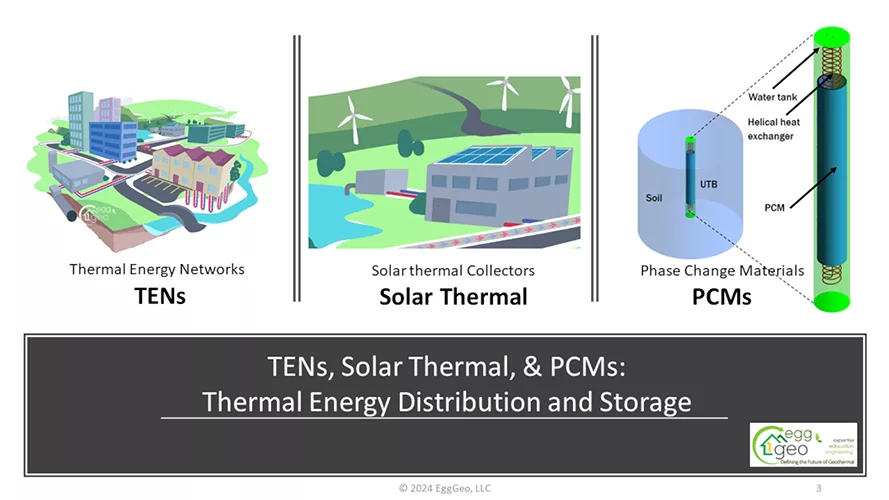We have had an electrical distribution network that started in 1882 when Thomas Edison’s Pearl Street Station in New York City began generating electricity for homes and businesses. We call it the electrical grid.
Thermal energy networks (TENs) are utility-scale infrastructure projects connecting multiple buildings into a shared network with sources of thermal energy such as geothermal boreholes, surface water, and wastewater.
Thermal energy refers to energy that changes the temperature of our spaces and the water we use in our homes and workplaces. Most people get thermal energy by burning fossil fuels in a boiler, furnace or water heater. However, much more efficient and clean ways exist to obtain thermal energy, such as from the earth, which holds a constant temperature year-round.
Many buildings around us also have waste heat that can be recycled and shared. For instance, large commercial, recreational and manufacturing buildings have excess thermal energy that other structures, such as homes and small commercial, can use in a shared network.
Why do we need TENs? There is a good reason; about half the energy consumed in the built environment is thermal energy. Computers, lights and various appliances must have electricity to operate. Space heating, cooling, and domestic hot water (DHW) needs may all be satisfied with thermal energy transfer. Let’s review some of the ways we can harvest renewable energy.
Energy Storage
The two general kinds of solar collectors are thermal and photovoltaic (PV). Solar thermal energy may be stored in a tank or the ground, and PV storage goes into electric batteries.
A PV panel can absorb solar energy and turn it into direct current (DC) electricity. The DC electricity is sent through inverters, converting it to alternating current and making it useful for homes and businesses. Because there is such an abundance of solar PV energy during daylight hours, battery storage has become an important technology to distribute that energy in the evening when the sun is not available as an energy source.
A solar thermal panel can store the thermal energy in holding tanks for later use. New technologies involving phase-change materials (PCMs) can also provide greater thermal storage with less volume. These may include water, wax or even molten salt in high-temperature applications. Remember that thermal energy storage works for cooling as well as heating.
Electrical storage gets the most attention because everybody needs electricity to run their homes and buildings. Thermal energy storage may seem less well-known. However, most buildings already have a DHW tank for thermal energy storage for hot water needs.
Solar thermal conversion efficiency is much higher than PV. You can extract about 70% of the sun’s energy within a given solar collector. This is accomplished by circulating heat transfer fluid through a solar thermal collector and capturing the thermal energy from the collector. Photovoltaic conversion is generally about 12%.
We store heat (or cold) using a thermal mass. This often requires a large, insulated storage tank to hold the heat. Thermal energy storage can be applied in individual buildings and at the network or regional level. Thermal energy is stored in large tanks of hot or cold water.
Other types are so-called “sensible” heat storage, such as using sand or rocks to store thermal energy. However, these approaches require large amounts of space, which limits their applications.
Materials changing phase from solid to liquid have the potential to store vast amounts of energy. PCMs absorb and release tremendous volumes of energy when transitioning between phases, typically from a liquid to a solid and vice versa.
When the temperature rises above the material’s melting point, the material changes phase and absorbs heat, thus cooling the medium. When the temperature drops, the material changes phase, giving up thermal energy.
PCMs have historically worked only in a given temperature range. In that case, two different materials are needed for summer and winter. Berkeley Labs and others have set out to create “dynamic tunability,” which does what the name states: it adjusts the phase change temperatures according to the needs of the process.
Batteries Vs. Thermal Storage
Is there a framework for people to compare batteries versus thermal storage? What if someone asked if they should install a lithium battery power wall or thermal energy storage?
Only recently, has there been a way to complete that comparison scientifically. This framework, which considers lifetime costs, was developed with researchers at the National Renewable Energy Laboratory and Oak Ridge National Laboratory (https://bit.ly/3Y0E10h). For example, thermal storage systems have lower capital costs to install, and the lifetime is typically 20 years or more. Electric batteries typically must be replaced after about eight years.
Every BTU of thermal energy that can be directly used in our buildings saves us conversion losses to which PV panels are subjected. Solar thermal has a higher conversion efficiency; thermal energy reduces reliance on electrical batteries.
Concerns with battery storage go beyond the conversion losses. Another is the cost of these batteries and the precious elements used in their manufacturing process, such as lithium. Thermal batteries use abundant materials such as water, salt and wax products that melt and solidify based on absorbing or giving up energy.
“If you think about how energy is consumed around the world, people think it’s consumed in the form of electricity, but it’s mostly consumed in the form of heat,” said Noel Bakhtian, executive director of Berkeley Lab’s Energy Storage Center. “If you want to decarbonize the world, you must decarbonize buildings and industry. That means you need to decarbonize heat. Thermal energy storage can play a significant role there.”
About half of the needs for energy in a home or commercial building are for space heating and DHW. That figure goes up dramatically when considering other facilities with high thermal energy needs, such as manufacturing and greenhouses.
Storing electrical energy is a necessary part of renewable energy technologies. However, every BTU of thermal energy directly used reduces our electrical load. This strategy, in turn, can reduce the electrical loads on our buildings and the number of electrical storage batteries needed for our built environment.
TENs are the solutions to moving this thermal energy around our communities. That’s why New York passed the Utility Thermal Energy Networks and Jobs Act of 2022 (https://bit.ly/4gGLclj), and many other states have followed its lead.
These energy networks can be installed under the street. Heat pumps in each building provide heating or cooling by exchanging thermal energy with a pipe containing circulating water as needed. The water in the piping system stays within the needed temperature range by exchanging heat with geothermal boreholes and other thermal resources.
As part of a holistic solution, TENs make it possible to use direct thermal energy to significantly reduce electrical demand and level the consumption of electricity year-round.





